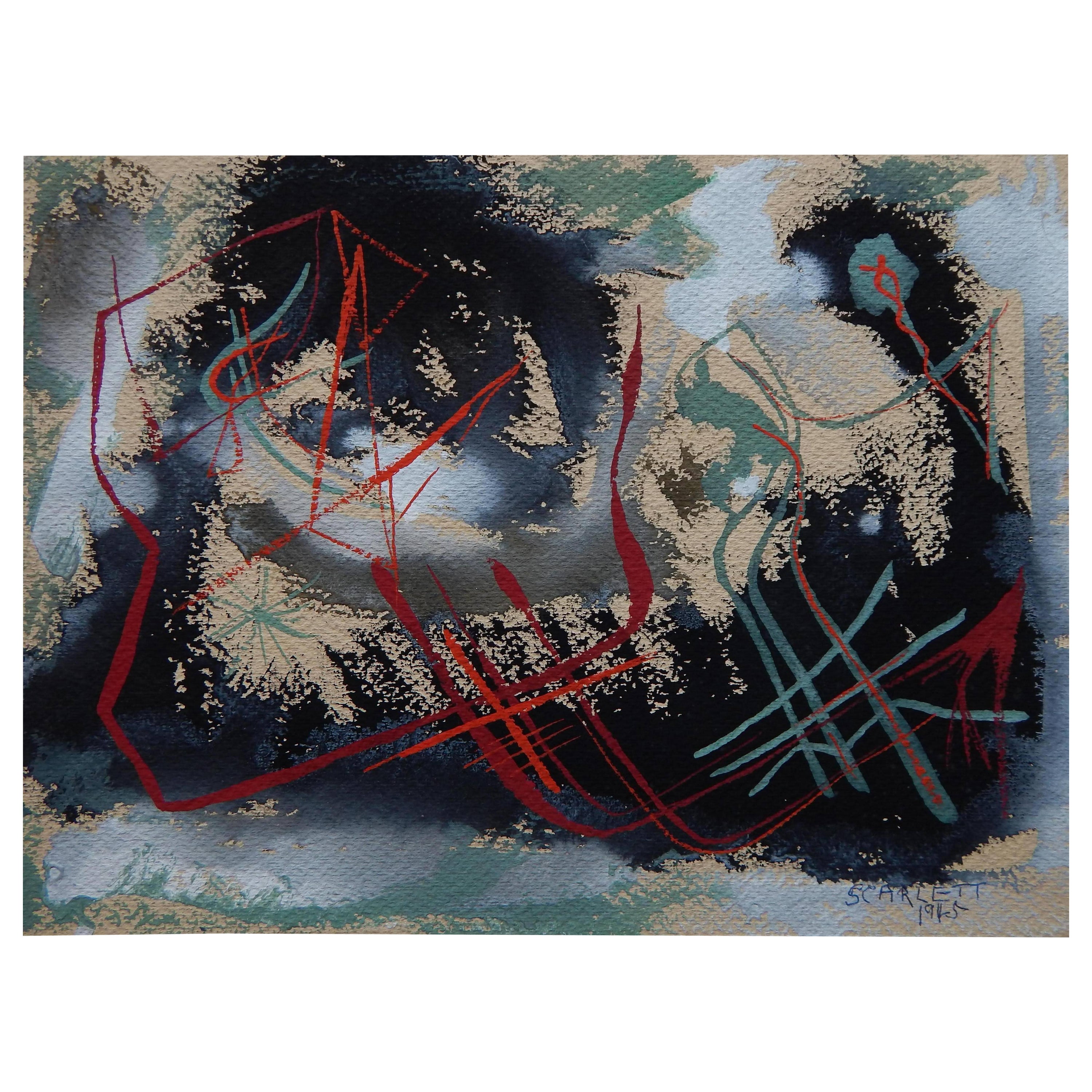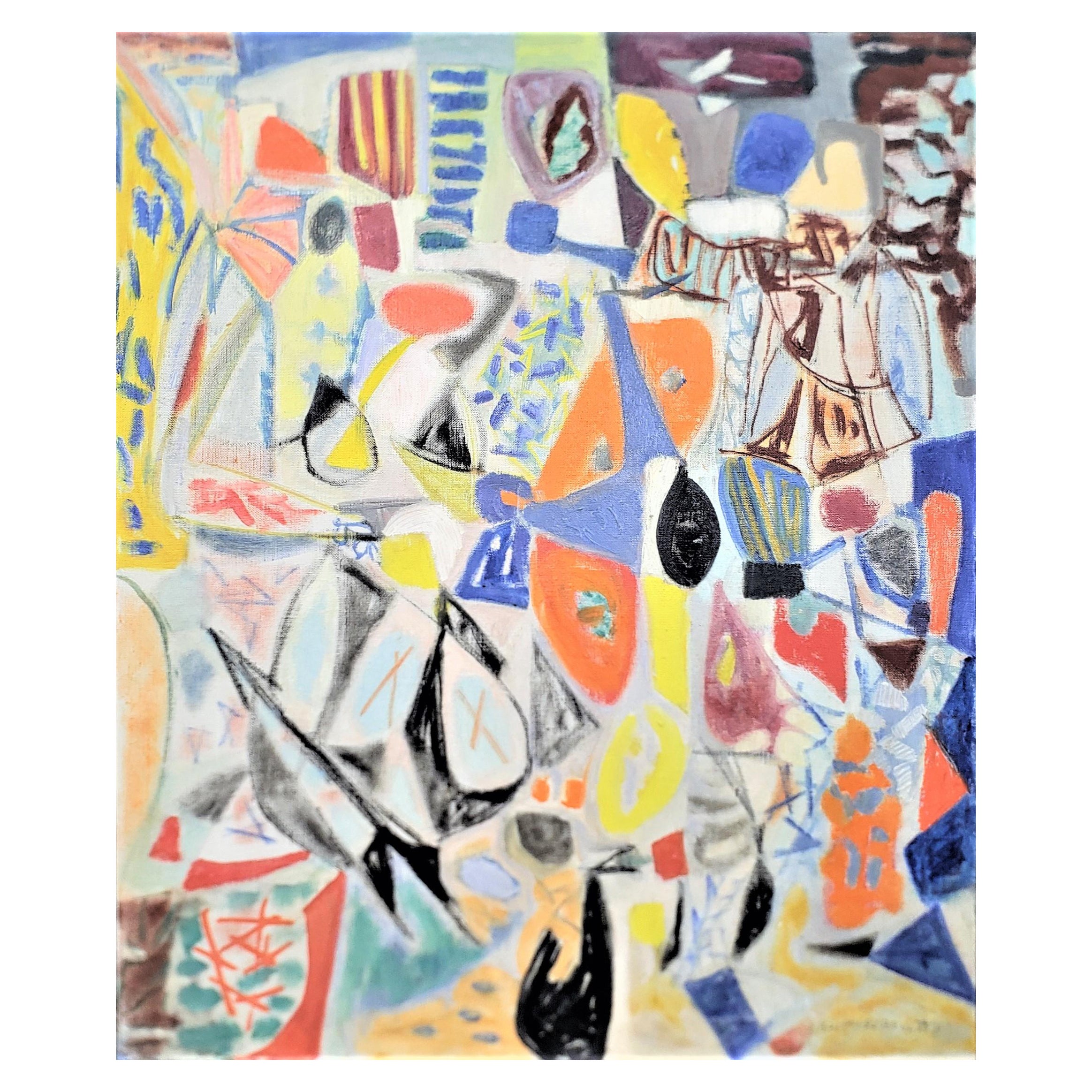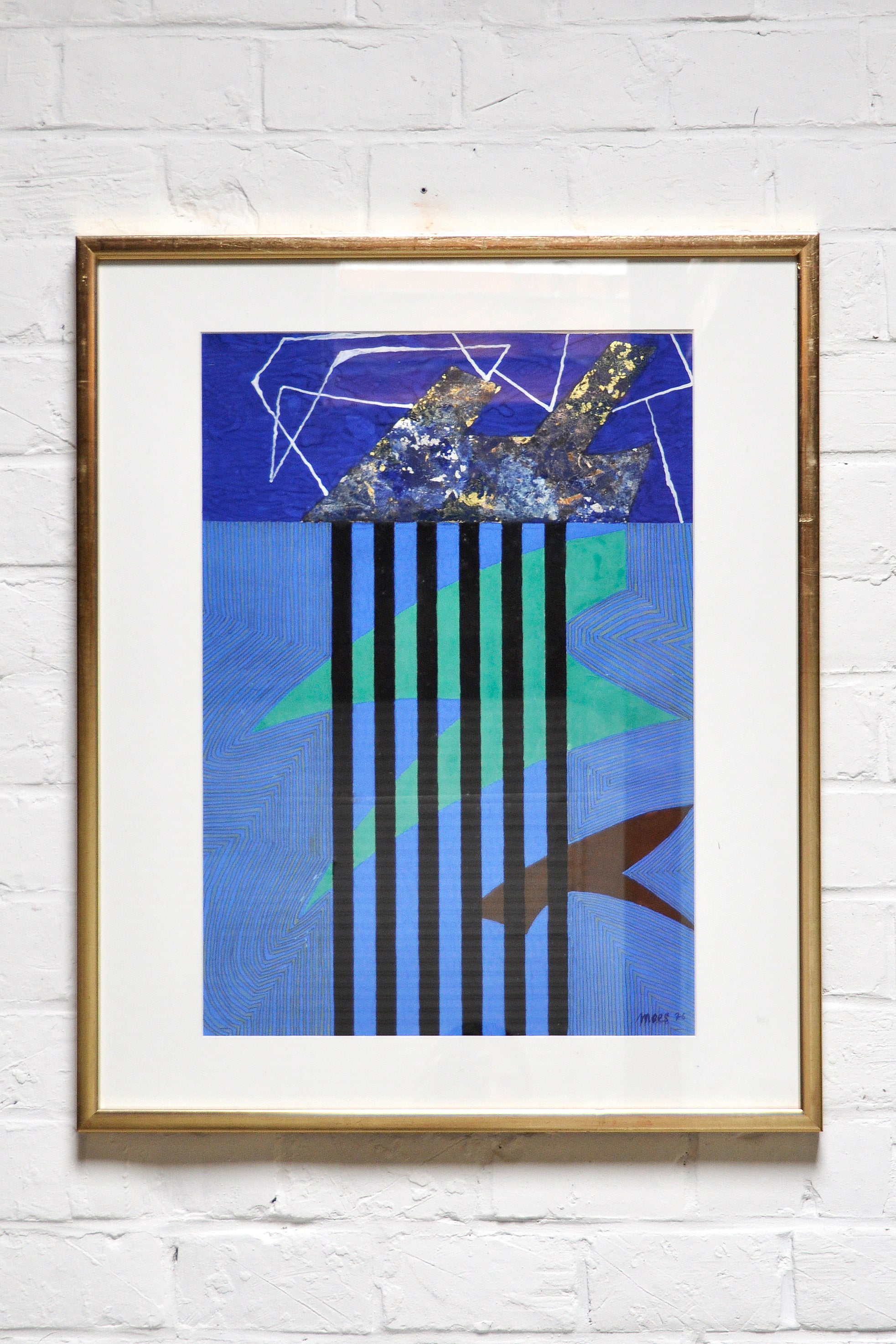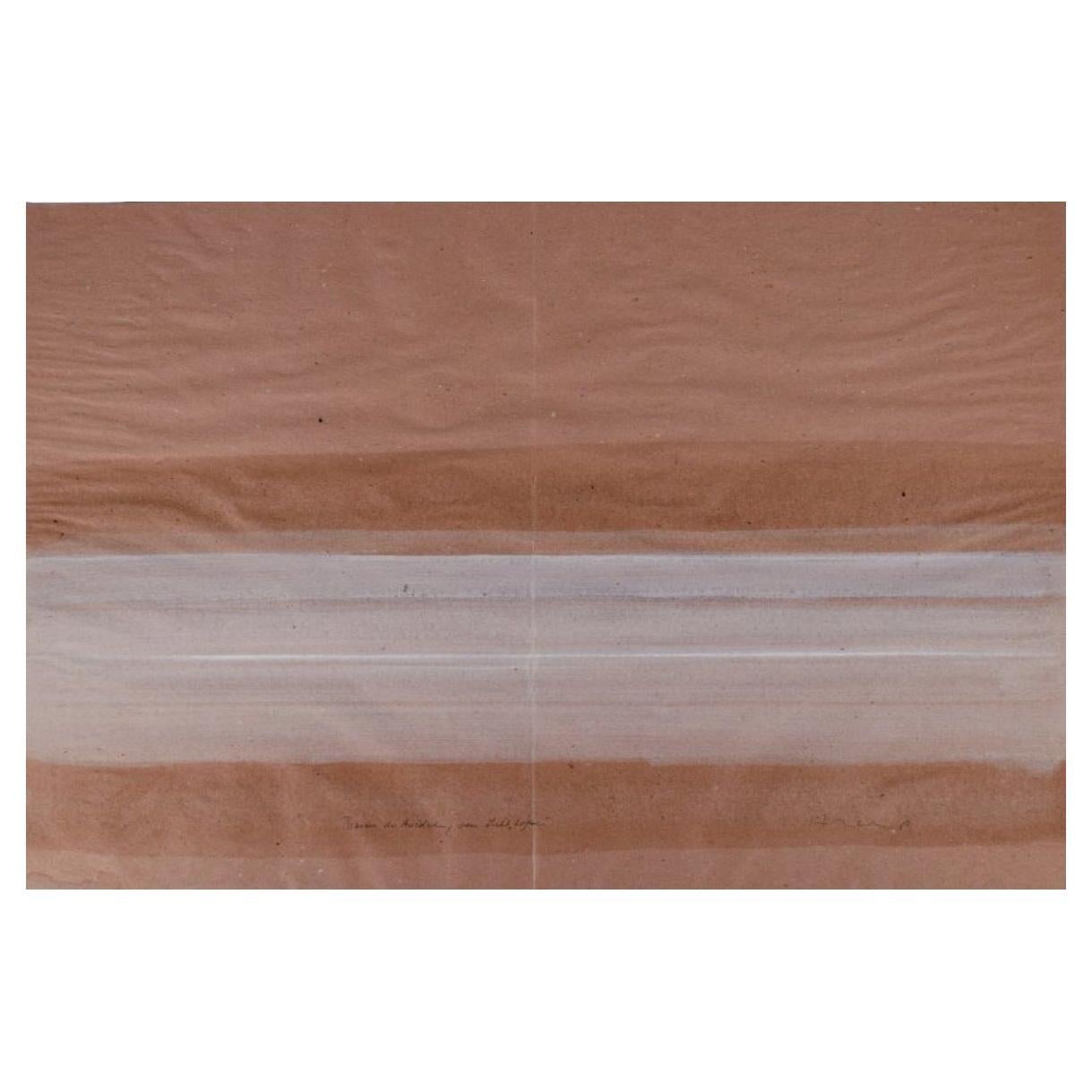Items Similar to Rolph Scarlett, Modernist Abstract Composition, Guache on Paper, Ca. 1950’s
Want more images or videos?
Request additional images or videos from the seller
1 of 8
Rolph Scarlett, Modernist Abstract Composition, Guache on Paper, Ca. 1950’s
About the Item
Artist: Rolph Scarletti (Canadian, 1889 – 1984)
Object: Modernist Abstract Composition
Period: Ca. 1950’s
Medium: Guache on paper, framed
Dimensions (unframed):
Height: 9-1/3”
Width: 12”
Dimensions (framed):
Height: 22-3/4””
Width: 25-3/4”
Rolph Scarlett (Canadian, 1889 – 1984) was a consummate explorer of twentieth-century abstract painting. Never afraid of trying new styles, curious and opinionated, constantly engaged with the world around him while steadfastly aware that he was on his own path and his alone, Scarlett more than once proved to be at the artistic zeitgeist of the eras in which he lived. Exposed very early on to the work of Paul Klee through a chance meeting in Europe with the artist himself, Scarlett took up abstraction with a fervor that never diminished during his long and impressive career. To create something that had never existed before: this was Scarlett’s great cause. And that is what is most obvious when you look at Scarlett’s work—you have never seen anything quite like it.
Scarlett was Canadian-born, came of age in the Midwest, and spent few important years in Hollywood, where he designed stage sets. His work from this early period echoes Klee’s use of color, his confidence in naïve, primitive forms, and his blend of abstraction and figuration. In its flat spatial qualities it prefigures the Indian Space painting of the 1940s by a decade. He moved to New York in 1933 and eventually found his first great patron at the Museum of Non-Objective Painting, directed by Baroness Hilla Rebay and art patron Solomon R. Guggenheim. Guggenheim would collect over 60 works by Scarlett for his collection, more than any other artist outside of Vasily Kandinsky and Rudolf Bauer.
As a frequent exhibitor and lecturer at the Museum of Non-Objective Painting (MNOP), Scarlett honed his sensitive feel for bodies in space and capitalized on his trademark use of bright, vivacious colors into accomplished, perfectly harmonized geometric works. However, Scarlett soon morphed these hard-edged forms into a nuanced expressionistic abstraction which, at its best, seems to be populated by dancing forms that animate the canvases. Along this way he was advised by Rudolf Bauer, the German expatriate and one of the originators of non-objective painting in the teens. Bauer had the idea for the Museum, and Rebay, his champion, had found in Solomon Guggenheim a patron for manifesting it. When Bauer emigrated just before World War II, he wanted to meet Scarlett. The two became friends, and Bauer advised Scarlett on his work over the course of many years. Even in a 1979 interview, Scarlett began to tear up as he recalled his first meeting with Bauer, a man whose work he "worshipped," describing that, "It was a touching moment for me, I’ll tell you."
Scarlett and Rebay also had a close, important relationship, one in which he bore the brunt of her sometimes condescending, if motherly, critiques and admonitions with tolerance and gratefulness. Eventually, though, he had to push back. In a letter from 1951 he writes, "I have noticed with growing amazement that during the past three years you have accepted less and less of my work—and, that same work, which you rejected has been accepted and shown in the best and largest shows all over this country."
This period—the late 1940s to the early 1950s—did in fact correspond to Scarlett’s most critical success, and to a return to the fanciful forms and characters of his pre-war work. At the same time, he found his own rhythm and complexity using a drip style similar to, though denser and more opaque than, the one made famous by Jackson Pollock, who had worked for many years at the MNOP and with whom he shared common influences. In 1949 he had a very well received solo show in 1949 at the Jacques Seligmann Gallery, reviewed very favorably in The New York Times: "The impression made by these paintings is one of originality and strength." He was also included in a juried show "American Painting Today" at the Metropolitan Museum of Art in 1950 and in the Whitney Annual of 1951. The curator for the Whitney show in fact bypassed a selection of Scarlett’s careful geometrics in favor of a new "lyrical" drip painting—one which he describes as having had "a helluva good time" making.
Rebay articulated her loss of control over Scarlett very keenly in one of her last official letters to him: "So your way ended in the horrid jungle it is in now; even a Mr. Pollock’s smearage was not bad enough for you to have a try at; and betraying yourself, you betrayed art and my faith in you, and my present disgrace by my failure to foresee such an outrageous possibility—since you even paint objectively now."
Yet, despite the fact that he was moving in his own direction when the change in leadership took place at the Museum of Non-Objective Painting and Rebay was forced out as director, Scarlett was hit hard. He understood this change rightly as a betrayal by the establishment. Scarlett was a unique individual and soul, and was affected personally and philosophically by the idea that the movement with which Scarlett had aligned his talents seemed to disappear overnight, and his life’s work rendered valueless.
Without the Museum’s support, Scarlett decided eventually to move to the artists’ community of Shady, New York, just outside of Woodstock. He had occasional shows throughout the years, but mostly settled down to regional obscurity. He began making jewelry, which had been his first trade, and it was following a show of his jewelry in 1975 at the Jaro Gallery, that he was rediscovered by Samuel Esses, and his wife Sandy.
Samuel Esses was a successful businessman and an avid collector. He always sought out that which was unusual and, like Scarlett, was ahead of his time in many ways. For example, in 1979, Sam became enthralled with the early graffiti appearing on the New York subway trains. With the sole goal of preserving these groundbreaking yet short lived works of art he was inspired to create "The Esses Studio," a painting warehouse and workshop for graffiti artists to work in a studio, collaborate, and paint on canvas. The biggest names of graffiti writing participated—Futura, Crash, Dondi, Zephyr, and Daze to name a few. The project was well received and provided critical validation at an important time for this alternative form of abstraction to be recognized by the established art world. The success of the "Esses Studio" helped fuel an alternative fire that would propel gallerists and curators to acknowledge other street artists and provide a foundation of acceptance for the early careers of Keith Haring and Jean-Michel Basquiat. It is not a stretch to say that what Esses saw in the graffiti art of the 1970s was very similar to what he saw in 1950s-era Scarletts—something raw, honest, and melding many twentieth century influences into one unique form. Inspired by the importance of the collection and the passion of the collector, Weinstein Gallery acquired the entire "Esses Collection of Paintings by Rolph Scarlett."
In spite of his self-imposed obscurity over the past half-century, Rolph Scarlett’s paintings are represented in a number of significant museum collections including the Guggenheim (which still owns over 30 works), the Smithsonian Institution, the Los Angeles County Museum of Art (from the important Leslie Collection), the Montreal Museum of Art, and the de Young Museum in San Francisco. The 2011 Weinstein Gallery exhibition Rolph Scarlett: Listen with Your Eyes represents first comprehensive retrospective of Scarlett’s paintings. It is our hope that once this collection is shown to a larger public, Scarlett will be recognized, as he was by Hilla Rebay, as one of the "greatest artists of our time."
- Creator:Rolph Scarlett (Artist)
- Dimensions:Height: 9.33 in (23.7 cm)Width: 12 in (30.48 cm)Depth: 2 in (5.08 cm)
- Style:Mid-Century Modern (Of the Period)
- Materials and Techniques:
- Place of Origin:
- Period:
- Date of Manufacture:circa 1950s
- Condition:Wear consistent with age and use. We make our best effort to provide a fair and descriptive condition report. Please examine photos attentively, as they are part of the description. Send us a message to request more details or discuss price.
- Seller Location:New York, NY
- Reference Number:1stDibs: LU2819323260072
About the Seller
5.0
Vetted Seller
These experienced sellers undergo a comprehensive evaluation by our team of in-house experts.
Established in 1993
1stDibs seller since 2017
68 sales on 1stDibs
Typical response time: 2 hours
- ShippingRetrieving quote...Ships From: New York, NY
- Return PolicyA return for this item may be initiated within 10 days of delivery.
More From This SellerView All
- Modernist Oil on Canvas Portrait of a Boxer by Joe Stein, ca. 1950sLocated in New York, NYMARKINGS Signed ‘Joe Stein’ NOTE Original un-restored period frame has a Paris art gallery label affixed on the reverse. ABOUT PAINTING T...Category
Vintage 1950s American Mid-Century Modern Paintings
MaterialsCanvas
- Alexander Cañedo, Dancing Man, Surrealistic O/C Painting, ca. 1950’sLocated in New York, NYMid-Century Surrealism Alexander Cañedo Dancing Man Oil on Canvas ca. 1950’s PAINTING DIMENSIONS: Canvas: 44 x 44 cm (17-3/8 x 17-3/8 in.) Framed: 68 x 68 cm (26-3/4 x 26-3/4 in.) Alexander Cañedo (Mexican-American, 1902 – 1978) was born in Mexico City as Alejandro de Cañedo; his father was a Mexican government official and his mother was from the United States. In 1918, when Cañedo was 15, his parents sent him to École nationale supérieure des Beaux-Arts in Paris where he studied under the sculptor Jean Magrou. In 1923, Cañedo traveled to Rome where he continued his art studies. In 1927, Cañedo briefly returned to Mexico. During that trip, the Mexican Government appointed him attaché to the Mexican Embassy in Rome. In 1928, Cañedo held his first art exhibition with the Circolo Artistico in Rome, a collection of pencil drawings. More exhibitions followed in other cities in Europe. That same year, he traveled to the New York City where he exhibited widely. At this point, he began signing his work with just his last name; eventually, he also Anglicized his first name as "Alexander" and dropped the "de". Cañedo was commissioned in 1929 to illustrate the amatory novel Orientale: The Adventure of Therese Beauchamps by the French author Francis de Miomandre. The highly stylized Art Deco results were so successful that he retained Cañedo the following year to illustrate his next novel, The Love Life of Venus. In 1932, Cañedo was invited to have a solo show of his pencil drawings at Walter P. Chrysler, Junior's newly opened Cheshire Gallery, located in the Chrysler Building. He also had a solo exhibition at the Argent Galleries, and participated in shows of the Art Students League of New York, of which he was an active member. By the mid-1930s, Cañedo began exhibiting watercolors. These were shown at solo exhibitions at the Arthur U...Category
Vintage 1950s American Mid-Century Modern Paintings
MaterialsPaint
- Stanley Stangren, Modernist Abstract Mixed-Media Collage, circa 1964By Stanley R. StangrenLocated in New York, NYDimensions: Unframed: 11-1/2 x 8-1/16 inches Framed: 17-1/8 x 12-7/8 inches Signed by the artist and dated ’64 in the lower right corner; inscribed in German: Zurich, Schweitz (Zurich, Switzerland) This unique work of art is a mixed-media collage on paper, where the artist had generously used his own pencil, gouache and watercolor drawing with a print cut-outs. Stanley R. Stangren (1928–2014) was an outstanding American jeweler, artist, sculptor and ceramist, residing in New York City. He worked in different styles and in different materials, including oils, watercolor, ceramic and stone sculptures; and fine jewelry. Stangren’s painting styles varied tremendously – from complete abstract works to Holocaust themes in the style of Georges Rouault and Hieronymus Bosch to portraits in the style of Moses and Raphael Soyer. He was also a passionate lover of the performing arts, and, as a young man, spent time studying dance at both the School of American Ballet and with Martha Graham. Although he worked with dance pioneers like Ms. Graham, Anna Sokolow and Charles Weidman, an injury prevented him from pursuing dance as a career. But he found other outlets for his artistic pursuits. In his youth, Stangrem attended the Brooklyn Museum School of Art, and graduated from the High School of Music and Art in New York City. He later studied at the Boston Museum of Fine Arts, the Art Students League, Bard Colledge and in Europe. Stangren studied jewelry design in Europe, attending Staatlische Kunst Werkschule in Pforzheim, Germany and Kunstgewerbeschule der Stadt in Zurich, Switzerland. His jewelry and designs were received with great success. His combination of precious and semi-precious stones, high-karat gold and sterling silver, and exotic materials executed with outstanding workmanship in the abstract modernist style gave a unique aspect to his designs, the metalwork usually electroformed, cast, or fused in varying textures. After returning to New York in the later 1950s, Stangren opened and maintained a ceramic business in Trenton, New Jersey. Very few pieces of his work remain from this period. When he retired from the ceramics business, he spent much of his time enjoying the arts. He frequently attended Juilliard performances, including most of the opera and drama presentations at the School, and was especially fond of the dance concerts. The last 40 years of his life, he taught painting in the New York area and worked with Metropolitan Museum of Arts in developing annuities, for future acquisitions. In addition, Stangren left annuities for MoMa in support of educational programs and left, in his will or through his executors, art supplies for the Harlem School of Art and benefits for the Urban Assembly organization. Mr. Stangren's love for the arts and for the performances he was seeing at Juilliard inspired him to take his participation a step further and to establish charitable gift annuities with the School. "I realized what Juilliard offered me, being a passionate music lover, and I decided to give something back" he said. "What Juilliard achieves is remarkable. When I think of the prominent actors, dancers and musicians that have been educated there, I am always staggered. It is deeply financially satisfying to be able to give back to the School, while benefitting from it at the same time." The Juilliard School is not the only organization that Stanley Stangren...Category
Vintage 1960s Swiss Mid-Century Modern Paintings
MaterialsPaper
- Girl and Bird, Original Watercolor, Gouache and Pencil on Paper, 1960sLocated in New York, NYA wonderful work of Mid-Century Modern art, framed. Artist’s signature is illegible Dimensions: Painting (only): 25 x 19.75 inches Painting (framed): 26 x 20.75 inches.Category
Vintage 1960s American Mid-Century Modern Paintings
MaterialsPaper
- Irina Shtenberg, Portrait of a Young Woman, Watercolor on Paper, circa 1940sLocated in New York, NYUnsigned. Attributed to Irina Valeryanovna Shtenberg. Period frame. Dimensions (unframed): Height: 13”, width: 11” Dimensions (framed): Height: 15”, width: 12-7/8” All the w...Category
Vintage 1940s Russian Mid-Century Modern Paintings
MaterialsPaper
- Boris Solotareff, Double-Portrait, Watercolor and Gouache on Paper, 1920sBy Boris SolotareffLocated in New York, NYBoris Solotareff (Russian, 1889-1966) was a Russian painter, who was active in Switzerland and France; but spent the majority of his career in New York City, where he became a natura...Category
Vintage 1920s French Art Deco Paintings
MaterialsPaint
You May Also Like
- Rolph Scarlett Abstract Expressionist Painting, 1945By Rolph ScarlettLocated in Phoenix, AZAbstract expressionist gouache and watercolor on paper by noted artist Rolph Scarlett - Signed and dated lower right. Archivally matted, unframed. Image size: 11" H x 15" W. In excellent condition. Rolph Scarlett was a painter of geometric abstraction during the American avant-garde movement of the 1930s and 1940s. Born in Guelph, Ontario, Canada in 1889, he left Canada at the age of 18 to go to New York City and returned to Canada during the years of World War I. However, by 1924 he had established New York City as his home. While he was beginning his career as an abstract painter, he was designing stage scenery for George Bernard Shaw...Category
Vintage 1940s American Mid-Century Modern Paintings
MaterialsPaper
- Rolph Scarlett Original Non-Objective Modernist Oil Painting on Canvas: UntitledBy Rolph ScarlettLocated in Hamilton, OntarioThis original painting was done by the well known Canadian-American Rolph Scarlett, dating to approximately 1950 and done in his Non-Objective Modern style. This abstract painting is...Category
Mid-20th Century Canadian Mid-Century Modern Paintings
MaterialsCanvas, Pine
- Rolph Scarlett Original Watercolor Dated 1952, Geometric AbstractionBy Rolph ScarlettLocated in Phoenix, AZAbstract watercolor by Rolph Scarlett, signed lower left. A great example by Scarlett. Measures: 19" H x 21" W image size. New modernist custom-made frame. Size: 24 1/4" H x 26 3/4" W. Rolph Scarlett was a painter of geometric abstraction during the American avant-garde movement of the 1930s and 1940s. Born in Guelph, Ontario, Canada in 1889, he left Canada at the age of 18 to go to New York City and returned to Canada during the years of World War I. However, by 1924 he had established New York City as his home. While he was beginning his career as an abstract painter, he was designing stage scenery for George Bernard Shaw...Category
Mid-20th Century American Mid-Century Modern Paintings
MaterialsPaper
- Abstract Guache Composition by Jozef Mees, Belgian Constructivism 1976Located in Zwijndrecht, AntwerpA colorful abstract gouache on paper by Belgian artist Jozef Mees, dated 1976. Framed behind glass with a golden frame. Jozef Mees (1998-1987) is a Belgi...Category
Vintage 1970s Belgian Mid-Century Modern Paintings
MaterialsPaper
- Edgar Hofschen, German artist. Watercolor on paper. Abstract composition.Located in Copenhagen, DKEdgar Hofschen (born 1941), German artist. Watercolor on paper. Abstract composition. Signed and dated in pencil, 1963. Perfect condition. Dimensions: Width 74.5 cm x Height 49.5 cm.Category
Vintage 1960s German Paintings
MaterialsOther
- Monique Beucher, French artist. Gouache on paper. Abstract composition.Located in Copenhagen, DKMonique Beucher (1934), French artist. Gouache on paper mounted on canvas. Abstract composition. Colorful palette. From the 1980s. In perfect condition. Exhibited at "La Galerie" 67 ...Category
Vintage 1980s French Paintings
MaterialsCanvas, Paper
Recently Viewed
View AllMore Ways To Browse
Making Vintage Jewelry
Unusual Mid Century Painting
1950s German Modernist
Alternative Wall Art
Wall Fire Place
Letter Man Painting
Vintage Jungle Painting
Midcentury Modern Studio Jewelry
San Francisco Retro Jewelry
Montreal Jewelry
World War 1 Jewelry
Self Made Man
Metropolitan Museum Of Art Jewelry Vintage
Basquiat New York Times
Letter To Mr
Retro Letter R
Canada Letter
Vintage Scarlett





